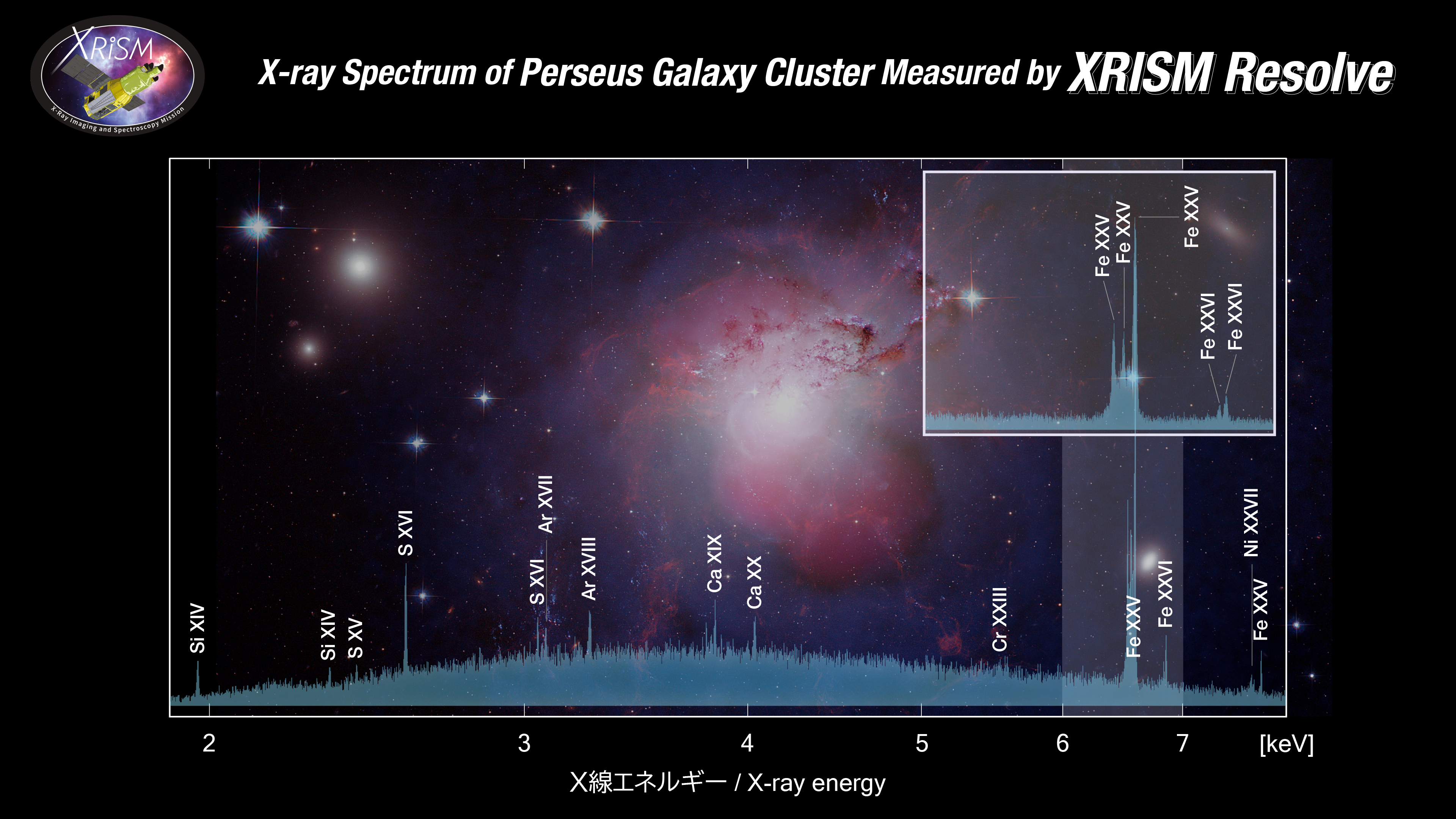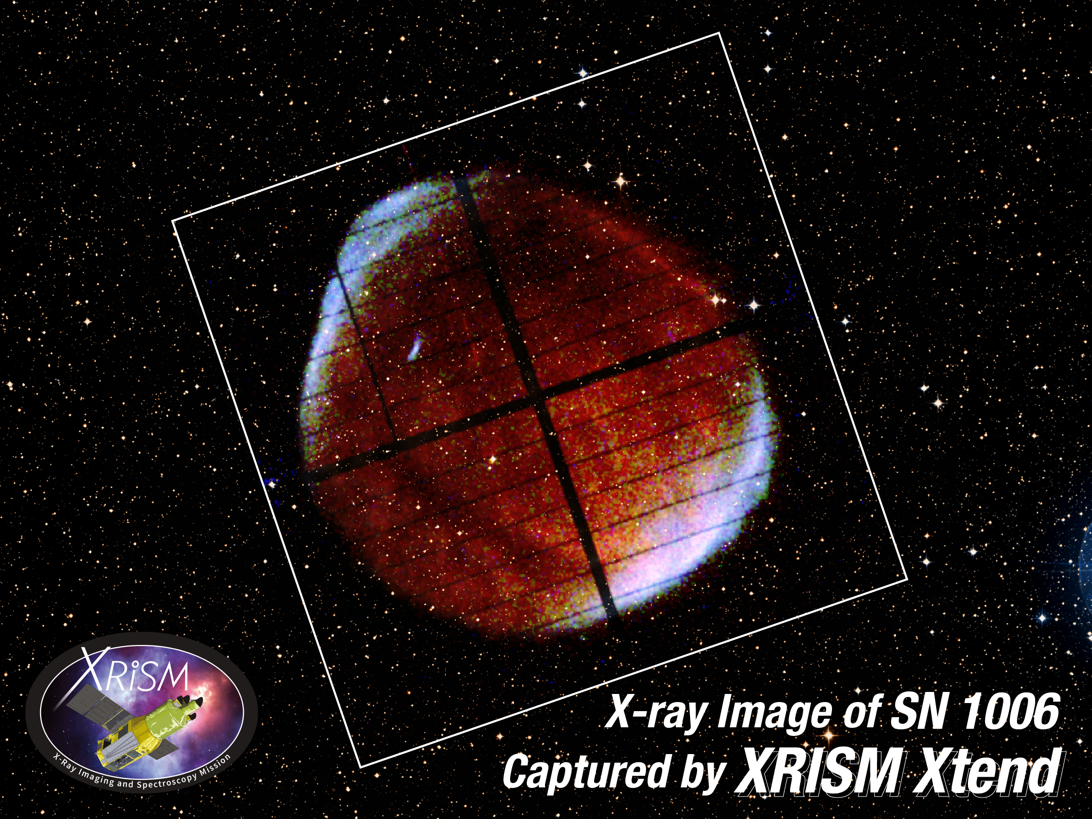X-ray Imaging and Spectroscopy Mission (XRISM) transition to nominal phase and release of early observation data
March 4, 2024 (JST)
Japan Aerospace Exploration Agency
The Japan Aerospace Exploration Agency (JAXA) is pleased to announce that the X-ray Imaging and Spectroscopy Mission (XRISM) completed its commissioning period as planned and has transitioned to the nominal phase.
XRISM is conducting an initial calibration and performance verification operation to understand the individual characteristics of its onboard instruments and improve observation accuracy. XRISM will then start astronomical observations based on proposals from global researchers.
We would like to express our deepest gratitude again to all parties involved for their cooperation and support during the commissioning period.
XRISM has achieved excellent instrument performance in orbit, including spectral performance that exceeds the initial target, and is expected to bring about a variety of discoveries in the future. The following two images are selected from the early science observation data.

Figure 1:
X-ray spectrum of the Perseus cluster obtained with XRISM's onboard soft X-ray spectrometer (Resolve). The background image is a composite image of X-ray, visible light, and radio near the observation area. The galaxy is NGC 1275 and is located at the center of the Perseus cluster. The graph in the upper right corner shows a spectrum from 6 keV to 7 keV.
(Credit: JAXA/NASA/CXC*/IoA**/A.Fabian et al./NRAO/VLA/G. Taylor/ESA/Hubble Heritage (STScI/AURA) /Univ. of Cambridge)
* Chandra X-ray Center ** the Institute of Astronomy in Cambridge, UK
Figure 1 shows a spectrum of the central region of the Perseus cluster, obtained with the soft X-ray spectrometer (Resolve) onboard XRISM. The Perseus cluster is a galaxy cluster (*1) located about 240 million light-years from Earth. It is the most luminous giant cluster of galaxies in X-rays.
The precise X-ray spectra from Resolve will reveal the distribution and motion of dark matter by measuring the temperature and velocity of the plasma. This data is expected to reveal how clusters of galaxies form and how they evolve.

Figure 2:
X-ray and visible light composite image of the supernova remnant SN 1006. the X-ray image was acquired by the soft X-ray imager (Xtend) onboard XRISM.
(Credit: X-ray: JAXA/Optical: DSS*** ) ***The Digitized Sky Survey
Figure 2 is an X-ray image of the supernova remnant SN 1006 taken by XRISM's onboard soft X-ray imager (Xtend). This object is the remnant of a supernova (*2) that exploded in 1006 AD. SN 1006 has expanded into a large spherical object 65 light-years in diameter over the 1,000 years since its explosion and is still expanding at 5,000 kilometers per second.
Thanks to Xtend's wide field of view, SN 1006, with an apparent visual diameter of about 30 arcminutes (about the same size as the full moon), could fit entirely within the image taken. This data will allow a detailed study of the abundance of elements created by the fusion reaction during the explosion, as well as the expansion of the remnant.
Early science data is now accessible on the XRISM researchers’ website (*3). This resource aims to support researchers globally in crafting precise observation proposals by offering insights into XRISM's performance. Stay tuned to our website for future updates on observation outcomes.
< Comments by MAEJIMA Hironori, XRISM Project Manager>
Following the successful completion of the initial functional verification for the satellite and ground systems, we have officially commenced nominal scientific observations. Our inaugural observations have revealed impressive performance, marking an auspicious beginning. Equipped with XRISM, an international X-ray observatory, we remain steadfast in our mission to unravel the mysteries of the Universe through continued exploration of celestial phenomena.
< Comments by TASHIRO Makoto, XRISM Principal Investigator>
At long last, scientific observations have commenced. The XRISM team will meticulously conduct in-orbit calibrations and disseminate scientific findings through performance verification observations. Following this, in approximately August, we will initiate observations based on proposals submitted by global researchers. We eagerly look forward to the opportunity of serving as an open observatory, contributing to scientific advancements.
*1:
A galaxy cluster, the most expansive entity in the cosmos, comprises numerous galaxies spanning 10 million light-years in diameter. Galaxies are drawn together by the gravitational force exerted by a mysterious substance known as "dark matter." This gravitational pull attracts galaxies and draws in hydrogen gas formed in the universe's early stages. This drawn-in hydrogen gas transforms into ultra-hot plasma, reaching tens of millions of degrees Kelvin and emitting vibrant X-ray radiation.
*2:
A supernova is an astronomical event characterized by a sudden, intense burst of luminosity resulting from a massive explosion originating from either a massive star or a white dwarf. SN 1006 is thought to have resulted from a significant eruption of a white dwarf. A white dwarf is a dense remnant left behind after the death of a Sun-like star. When a white dwarf forms a binary system with another star, the gravitational pull causes material from the companion star to accrete onto the white dwarf. This process triggers a runaway nuclear fusion reaction within the white dwarf, leading to a catastrophic explosion of the entire system.
Related Links
- XRISM Special Site
- XRISM project website
- XRISM official XExternal Link